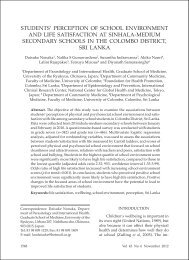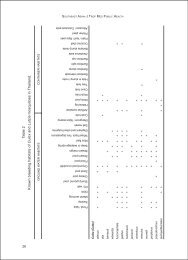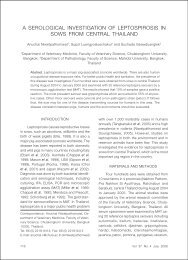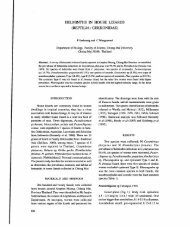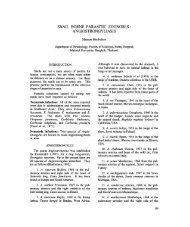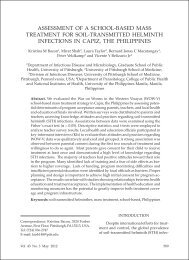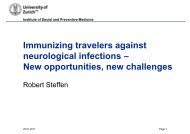research note - Faculty of Tropical Medicine, Mahidol University
research note - Faculty of Tropical Medicine, Mahidol University
research note - Faculty of Tropical Medicine, Mahidol University
You also want an ePaper? Increase the reach of your titles
YUMPU automatically turns print PDFs into web optimized ePapers that Google loves.
Correspondence: Aree Pethleart, Department<br />
<strong>of</strong> Parasitology, <strong>Faculty</strong> <strong>of</strong> <strong>Medicine</strong>,<br />
Thammasat <strong>University</strong>, Klong Luang, Pathum<br />
Thani, Thailand.<br />
E-mail: pethleart@yahoo.com<br />
SOUTHEAST ASIAN J TROP MED PUBLIC HEALTH<br />
RESEARCH NOTE<br />
PREVALENCE AND RISK FACTORS FOR PINWORM<br />
INFECTION IN THE KINDERGARTEN OF THAMMASAT<br />
UNIVERSITY, THAILAND<br />
Aree Pethleart 1 , Prasert Saichua 1 , Pochong Rhongbutsri 1 , Ratree Leelawongtawon 2 ,<br />
Kalaya Aree 1 , Rattana Tiengtip 1 , Choosak Nithikathkul 2 , Saengchai Nateeworanart 3<br />
and WRJ Taylor 4<br />
1 Department <strong>of</strong> Preclinical Science, <strong>Faculty</strong> <strong>of</strong> <strong>Medicine</strong>, Thammasat <strong>University</strong>,<br />
Pathum Thani; 2 <strong>Faculty</strong> <strong>of</strong> Science and Technology, Huachiew Chalermprakiat <strong>University</strong>,<br />
Samut Prakan; 3 <strong>Faculty</strong> <strong>of</strong> Medical Science, Naresuan <strong>University</strong>, Pitsunulok, Thailand;<br />
4 Division <strong>of</strong> International and Humanitarian <strong>Medicine</strong>, Geneva <strong>University</strong> Hospitals,<br />
Switzerland<br />
Abstract. We studied the prevalence and risk factors for pinworm infection in<br />
children attending the kindergarten <strong>of</strong> Thammasat <strong>University</strong>, Pathum Thani,<br />
Thailand, using the Scotch-tape technique. Slides were examined by a standard<br />
light microscope; 20% <strong>of</strong> negative slides were reexamined for quality control. Symptoms<br />
and risk factor data were collected using a structured questionnaire. Three<br />
hundred thirty children age 3 to 6 years old were sampled (males=159). Sixty-five<br />
(19.7%) had symptoms consistent with pinworm infection. No pinworm eggs were<br />
detected. Most parents (73%) had a good socioeconomic status and 64% were<br />
university graduates. Pinworm infection may be uncommon in urban Thailand.<br />
Key words: pinworm, Scotch-tape technique, socioeconomic status<br />
INTRODUCTION<br />
Enterobius vermicularis is an intestinal<br />
nematode that has been reported in different<br />
parts <strong>of</strong> Thailand. The infection rates<br />
in children from a slum area <strong>of</strong> Bangkok<br />
ranged from 53 to 85% (Vajarasthira and<br />
Harinasuta, 1960; Tepmongkol and<br />
Suntadwoot, 1980). Similar rates were<br />
found in preschool children in Khon Kaen,<br />
northeastern Thailand (50.9%) (Kaewkes<br />
et al, 1983), in preschool children in Chiang<br />
Mai (45.4%) (Tukaew et al, 2002) and in<br />
hilltribe children in rural Chiang Mai<br />
(41.6%) (Chaisalee et al, 2004). The prevalence<br />
rate in preschool age children in Karen<br />
hill tribes in Mae Hong Son, north western<br />
Thailand, was only 7% (Nithikathkul et al,<br />
2003). Other surveys in school children <strong>of</strong><br />
different ages found rates <strong>of</strong> under 22% in<br />
Bangkok (Changsap et al, 2002) and under<br />
39% in Samut Prakan Province, Thailand<br />
(Nithikathkul et al, 2001).<br />
Transmission <strong>of</strong> pinworm is limited<br />
because, unlike the soil transmitted helminths,<br />
its eggs cannot survive for long in<br />
the environment. The routes <strong>of</strong> infection<br />
306 Vol 41 No. 2 March 2010
are fecal-oral, such as by finger licking after<br />
anal scratching due to anal pruritus<br />
(Herrstrom et al, 1997); exposure to eggs<br />
from bed sheets, pyjamas or other fomites;<br />
inhalation <strong>of</strong> eggs in dust; and autoinfection<br />
where eggs hatch on the anal mucosa<br />
and the larvae migrate up into the bowel.<br />
Transmission occurs mostly in limited environments,<br />
such as amongs families, in<br />
nurseries or boarding schools.<br />
Many cases <strong>of</strong> E. vermicularis infection<br />
are asymptomatic. The most common<br />
symptoms experienced include itching <strong>of</strong><br />
the perianal and vaginal areas. These<br />
symptoms may be accompanied by mild<br />
nausea, vomiting, abdominal pain, irritability<br />
or difficulty sleeping. Anorexia and<br />
weight loss may be present and, in small<br />
children, poor gut absorption contributes<br />
to the development <strong>of</strong> malnutrition, reduced<br />
growth and development. Heavy<br />
infection may cause intestinal inflammation<br />
and abdominal pain with secondary<br />
bacterial infection and appendicitis<br />
(Babekir and Devi, 1990). The parasite can<br />
affect other organs, such as the vagina,<br />
uterus and gall bladder (Khan et al, 1981).<br />
Personal hygiene is important for the<br />
prevention and control <strong>of</strong> pinworm; this<br />
includes hand washing before eating and<br />
keeping the nails short. Other useful measures<br />
are cleaning beds regularly and drying<br />
mattresses under sunlight in order to<br />
destroy the eggs.<br />
The Scotch tape technique is an accepted<br />
method to detect eggs from the<br />
peri-anal region. It is convenient, quick,<br />
inexpensive, used widely and sensitive<br />
(Akagi, 1973; Cho and Kang, 1975; Kim et<br />
al, 2001; Cabello Rodriguez, 2003). There<br />
are no data on the prevalence <strong>of</strong> Enterobius<br />
vermicularis in children in Pathum<br />
Thani Province, therefore, a pilot study to<br />
examine its prevalence and risk factors<br />
PINWORM INFECTION IN KINDERGARTEN<br />
was conducted in the kindergarten <strong>of</strong><br />
Thammasat <strong>University</strong>.<br />
MATERIALS AND METHODS<br />
The kindergarten <strong>of</strong> Thammasat <strong>University</strong>,<br />
Pathum Thani, Thailand, is situated<br />
on the campus <strong>of</strong> Thammasat <strong>University</strong>.<br />
It admits children age 3 to 6 years old<br />
who are either the children <strong>of</strong> university<br />
employees or from the local area. The total<br />
number <strong>of</strong> children attending the kindergarten<br />
is 467.<br />
The study took place in September<br />
2006. Consent forms and questionnaires<br />
were sent to the parents <strong>of</strong> the 467 children.<br />
Those parents interested in the study<br />
were interviewed and the study procedures<br />
explained. Once written informed<br />
consent was obtained, parents were asked<br />
not to wash their child’s bottom on the day<br />
<strong>of</strong> the Scotch tape test (Kim et al, 2001;<br />
Triteeraprapab, 2007). The questionnaire<br />
was also completed by the parents. The<br />
Scotch tape technique was used and all<br />
children were sampled once. After applying<br />
the Scotch tape to the anus, the tape<br />
was stuck to a slide and examined using a<br />
standard light microscope at x 40 magnification.<br />
This study was approved by the<br />
<strong>Faculty</strong> <strong>of</strong> <strong>Medicine</strong>, Thammasat <strong>University</strong><br />
Ethics Committee.<br />
The completed questionnaires were<br />
coded, double entered, validated and<br />
analysed using Epidata version 4 and Stata<br />
version 6 (Stata Corporation, USA). The<br />
significance <strong>of</strong> differences in categorical<br />
data was examined using chi-square test<br />
unless the expectation on the null hypothesis<br />
was
Number<br />
80<br />
70<br />
60<br />
50<br />
40<br />
30<br />
20<br />
10<br />
0<br />
K 1 K 2<br />
Class<br />
K 3<br />
Fig 1–Distribution <strong>of</strong> children by sex and kindergarten<br />
class.<br />
Number<br />
200<br />
150<br />
100<br />
50<br />
0<br />
were sampled (males=159) (Fig 1). Most<br />
children were in age 5-6 years old (Table 1).<br />
Most parents (242/330, 73%) were pr<strong>of</strong>essionals<br />
with high income (Table 2) and<br />
(212/330, 64%) were university graduates<br />
(Fig 2). The reported symptoms during the<br />
previous month are shown in Table 3.<br />
Eighty-eight households (27%) had domestic<br />
pets; dogs were the most common<br />
pets, followed by cats. No pinworm eggs<br />
were detected in any <strong>of</strong> the examined children.<br />
SOUTHEAST ASIAN J TROP MED PUBLIC HEALTH<br />
Girl<br />
Boy<br />
Primary Secondary College Bachelor Higher than<br />
bachelor<br />
Education<br />
Fig 2–Parental educational level.<br />
Table 1<br />
Distribution <strong>of</strong> children by age.<br />
Age (year) Number %<br />
3 59 17.88<br />
4 100 30.30<br />
5 117 35.46<br />
≥6 54 16.36<br />
Total 330 100<br />
Table 2<br />
Parental income in Thai baht<br />
(USD 1 = THB 34).<br />
Income (Thai baht) Number %<br />
Less than 5,000 1 0.3<br />
5,000-7,000 11 3<br />
7,001-9,000 11 3<br />
9,001-11,000 19 6<br />
11,001-13,000 46 14<br />
More than 13,001 242 73<br />
Total 330 100<br />
Table 3<br />
Proportions <strong>of</strong> children reporting<br />
symptoms in the month prior to the<br />
Scotch tape examination.<br />
Symptoms N=330 %<br />
Anal itching 65 20<br />
Diarrhea 50 15<br />
Anorexia 100 30<br />
Fever 202 61<br />
DISCUSSION<br />
In this study, we did not find the eggs<br />
<strong>of</strong> Enterobius vermicularis in any <strong>of</strong> the 330<br />
kindergarten children. The children were<br />
in a high risk group, as has been shown in<br />
Thailand and in many other studies from<br />
developed and developing countries<br />
308 Vol 41 No. 2 March 2010
(Tepmongkol and Suntadwoot, 1980;<br />
Kaewkes et al, 1983; Mercado and Garcia,<br />
1996; Saksirisampant et al, 2004; de<br />
Carvalho et al, 2006; Ozgumus and<br />
Karaoglu, 2007; Requena et al, 2007;<br />
Triteeraprapab, 2007).<br />
There are several reasons which could<br />
explain these negative results. We used the<br />
Scotch tape technique because it is well established,<br />
safe and fairly sensitive (Akagi,<br />
1973; Cho and Kang, 1975; Kim et al, 2001;<br />
Cabello Rodriguez, 2003). Sampling was<br />
done in the morning, consistent with other<br />
studies, but was done at the kindergarten<br />
and not in the early morning at the patients’<br />
homes. The optimal time to sample a child<br />
is in the morning after the child wakes up,<br />
before they wash. We asked the parents not<br />
to wash their children s’ bottoms on the day<br />
we collected the samples but this may not<br />
have been done in all cases. It would have<br />
been better to teach the parents how to<br />
sample their children. We only did one test<br />
per child; several studies have shown that<br />
sensitivity increases with increased number<br />
<strong>of</strong> sampling times (Gilman et al, 1991;<br />
Yoon et al, 2000).<br />
The majority <strong>of</strong> our children came from<br />
high income, educated families, so it is possible<br />
the prevalence in such children is low<br />
because <strong>of</strong> awareness <strong>of</strong> personal hygiene.<br />
Our sample size and one Scotch tape test<br />
may have been inadequate to detected pinworms<br />
if the true prevalence were very low.<br />
Larger studies than ours have detected low<br />
rates <strong>of</strong> pinworms, eg 0.09% (n=1,010) in<br />
India and 0.3% in Nigeria (n=1,059) (Singh<br />
et al, 2004; Agbolade et al, 2007).<br />
Although no pinworms were detected<br />
in this study, we were able to educate children,<br />
parents and teachers about the transmission,<br />
prevention and control <strong>of</strong> this<br />
parasite.<br />
We studied only one group <strong>of</strong> children<br />
PINWORM INFECTION IN KINDERGARTEN<br />
from relatively well <strong>of</strong>f backgrounds in a<br />
small geographical location. This was intended<br />
as a pilot study to determine the<br />
prevalence <strong>of</strong> pinworm infection in the<br />
community; we are planning a larger<br />
cross-sectional survey.<br />
ACKNOWLEDGEMENTS<br />
We are grateful to Thammasat <strong>University</strong><br />
for financially supporting this study.<br />
We wish to thank the director and teachers<br />
<strong>of</strong> the kindergarten <strong>of</strong> Thammasat<br />
<strong>University</strong> and the parents without whose<br />
cooperation and support, this work would<br />
not have been possible.<br />
REFERENCES<br />
Agbolade OM, Agu NC, Adesanya OO, et al.<br />
Intestinal helminthiases and schistosomiasis<br />
among school children in an urban<br />
center and some rural communities in<br />
southwest Nigeria. Korean J Parasitol. 2007;<br />
45: 233-8.<br />
Akagi K. Enterobius vermicularis and enterobiasis.<br />
Prog Med Parasitol Japan 1973; 5: 229-<br />
79.<br />
Babekir AR, Devi N. Analysis <strong>of</strong> the pathology<br />
<strong>of</strong> 405 appendices. East Afr Med J.<br />
1990; 67: 599-602.<br />
Cabello Rodriguez M. Egg positive rate <strong>of</strong><br />
Enterobius vermicularis <strong>of</strong> primary school<br />
children in Geoje island. Korean J Parasitol<br />
2003; 41: 75-7.<br />
Chaisalee T, Tukaew A, Suwansaksri J,<br />
Wiwanitkit V, Suyaphan A. Very high<br />
prevalence <strong>of</strong> enterobiasis among the<br />
hilltribal children in rural district Mae<br />
Suk, Thailand. Med Gen Med 2004; 6: 5.<br />
Changsap B, Nithikathkul C, Boontan P,<br />
Wannapinyosheep S, Vongvanich N,<br />
Poister C. Enterobiasis in primary schools<br />
in Bang Khun Thian District, Bangkok,<br />
Thailand. Southeast Asian J Trop Med Public<br />
Health 2002; 33 (suppl 3): 72-5.<br />
Cho S, Kang S. Significance <strong>of</strong> scoth-tape anal<br />
Vol 41 No. 2 March 2010 309
swab technique in diagnosis <strong>of</strong> Enterobius<br />
vermicularis infection. Korean J Parasitol<br />
1975; 13: 102-14.<br />
de Carvalho TB, de Carvalho LR, et al. Occurrence<br />
<strong>of</strong> enteroparasites in day care centers<br />
in Botucatu (Sâo Paulo State, Brazil)<br />
with emphasis on Cryptosporidium sp, Giardia<br />
duodenalis and Enterobius vermicularis.<br />
Rev Inst Med Trop Sao Paulo 2006; 48: 269-<br />
73.<br />
Gilman RH, Marquis GS, Miranda E. Prevalence<br />
and symptoms <strong>of</strong> Enterobius<br />
vermicularis infections in a Peruvian<br />
shanty town. Trans R Soc Trop Med Hyg<br />
1991; 85: 761-4.<br />
Herrstrom P, Fristrom A, Karlsson A, Hogstedt<br />
B. Enterobius vermicularis and finger sucking<br />
in young Swedish children. Scand J<br />
Prim Health Care 1997; 15: 146-8.<br />
Kaewkes S, tessana S, Sithithaworn P,<br />
Srisawangwonk T, Raengsangounwong P.<br />
Enterobiasis in yong school children in<br />
Khon Kaen. Parasitol Trop Med Assoc Thai<br />
1983; 19-24.<br />
Khan JS, Steele RJ, Stewart D. Enterobius<br />
vermicularis infestation <strong>of</strong> the female genital<br />
tract causing generalised peritonitis.<br />
Case report. Br J Obstet Gynaecol 1981; 88:<br />
681-3.<br />
Kim BJ, Yeon JW, Ock MS. Infection rates <strong>of</strong><br />
Enterobius vermicularis and Clonorchis<br />
sinensis <strong>of</strong> primary school children in<br />
Hamyang-gun, Gyeongsangnam-do<br />
(province), Korea. Korean J Parasitol 2001;<br />
39: 323-5.<br />
Mercado R, Garcia M. Various epidemiological<br />
aspects <strong>of</strong> Enterobius vermicularis infection<br />
in patients served at public outpatient<br />
clinics and hospitals from the northern<br />
section <strong>of</strong> Santiago, Chile, 1995. Bol Chil<br />
Parasitol 1996; 51: 91-4.<br />
Nithikathkul C, Changsap B, Wannapinyosheep<br />
S, Poister C, Boontan P. The prevalence<br />
<strong>of</strong> Enterobius vermicularis among primary<br />
school students in Samut Prakan<br />
Province, Thailand. Southeast Asian J Trop<br />
Med Public Health 2001; 32 (suppl 2): 133-7.<br />
SOUTHEAST ASIAN J TROP MED PUBLIC HEALTH<br />
Nithikathkul C, Polseela P, Poodendan W,<br />
et al. Malaria and enterobiasis infection<br />
from Karen long neck tribe in Mae Hong<br />
Son Province. Southeast Asian J Trop Med<br />
Public Health 2003; 34: 25-28.<br />
Ozgumus OB, Karaoglu SA. Screening <strong>of</strong> intestinal<br />
parasites <strong>of</strong> children in special day<br />
nurseries in the city <strong>of</strong> Rize. Turkiye<br />
Parazitol Derg 2007; 31: 205-7.<br />
Requena I, Jimenez Y, Rodriguez N, et al. Enterobius<br />
vermicularis in preschool children<br />
from a suburban area in San Felix, Bolivar<br />
State, Venezuela]. Invest Clin 2007; 48: 277-<br />
86.<br />
Saksirisampant W, Prownebon J, Kanmarnee P,<br />
Thaisom S, Yenthakam S, Nuchprayoon S.<br />
Prevalence <strong>of</strong> parasitism among students<br />
<strong>of</strong> the Karen hill-tribe in Mae Chame district,<br />
Chiang Mai province, Thailand. J Med<br />
Assoc Thai 2004; 87 (suppl 2): S278-83.<br />
Singh HL, Singh NB, Yi S. Helminthic infestation<br />
<strong>of</strong> the primary school-going children<br />
in Manipur. J Commun Dis 2004 36: 111-6.<br />
Tepmongkol M, Suntadwoot CL. Enterobius<br />
infection in young school children in slum<br />
Klongtoei. Siriraj Hosp Gaz 1980; 32: 597-<br />
600.<br />
Triteeraprapab S. Computer Assisted Instruction<br />
Center (C.A.I) for Enterobius<br />
vermicularis. Bangkok: <strong>Faculty</strong> <strong>of</strong> <strong>Medicine</strong>,<br />
Chulalongkorn <strong>University</strong>, 2007.<br />
[Cited 2008 Oct 17]. Available from: URL:<br />
http://cai.md.chula.ac.th<br />
Tukaew A, Chaisalee T, Nithiuthai S, et al. Enterobius<br />
vermicularis infection among preschool<br />
children in Karen hilltribe villages<br />
in Chiang Mai, Thailand. Southeast Asian J<br />
Trop Med Public Health 2002; 33 (suppl 3):<br />
70-1.<br />
Vajarasthira A, Harinasuta C. The incidence<br />
<strong>of</strong> enterobiasis among children <strong>of</strong> five<br />
schools and two hospitals in Bangkok.<br />
Ann Trop Med Parasitol 1960; 54: 129-31.<br />
Yoon HJ, Choi YJ, Lee SU, Park HY, Huh S, Yang<br />
YS. Enterobius vermicularis egg positive<br />
rate <strong>of</strong> pre-school children in Chunchon,<br />
Korea. Korean J Parasitol 1999; 38: 279-81.<br />
310 Vol 41 No. 2 March 2010



